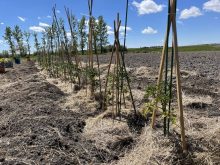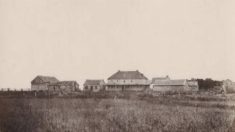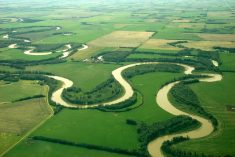This story has been reposted in recognition of the National Day for Truth and Reconciliation on Sept. 30. For more stories of Indigenous farming, food sovereignty, challenges and triumphs in the ongoing work of reconciliation, see our Truth and Reconciliation landing page.
Whose land was this? As truth and reconciliation have come to the fore of public discourse, it’s a question that has caused me some unease.
I’m a Mennonite by heritage and religion. I’ve spent most of my life on or near the “motherland” of Steinbach.
Read Also

Seeding Indigenous agricultural prosperity
National Circle for Indigenous Agriculture and Food says Indigenous agricultural success needs strong relationships.
In that time, I’ve picked up on — shall we say — a certain whiff of Mennonite snobbery; a slight savour of self-righteousness born of piety mixed with prosperity. I’ve had that attitude myself, at times.
I am not the only one who has noticed this. Cornelius J. Dyck notes a “certain Mennonite hauteur and condescension” in the book An Introduction to Mennonite History.
In his case, it was an attitude toward Ukrainian neighbours when Mennonites lived in settlements in that country. The ethno-religious group moved into Ukraine and within a couple of generations had established thriving farms and businesses.
When Mennonites became concerned about threats to their religious and cultural freedom, groups emigrated to Canada. They settled on land the government offered them and, through hardship, became prosperous again.
It’s human nature to think this was due to the staunch Mennonite work ethic. To be sure, the Mennonite work ethic is real. I consider it one of my greatest strengths and most pernicious weakness.
Still, was that the only factor? Or did the Mennonites also succeed off the backs of others, for example by settling land they had no right to?

Bare and unsettled land?
Steinbach is an original Mennonite settlement on the East Reserve, a wedge-shaped tract of land in southeastern Manitoba bounded in the north by Niverville and Blumenort and in the south by a line about 20 miles from the U.S. border, as per the Global Anabaptist Mennonite Encyclopedia Online.
The reserve is inside the boundaries of Treaty 1, which was signed in August 1871, about three years before the Mennonites arrived.
In a nutshell, the treaty is an agreement between Canada and the Anishinabek and Maskêkowiyiniwak (Swampy Cree) nations. It set aside reserves of land for First Nations and ceded a swath of southeast and south-central Manitoba to Canada, said the Canadian Encyclopedia.
It’s not clear if the First Nations realized that Canada intended to kick them off the land and confine them to reserves.
Some Indigenous scholars suggest “it is unlikely the Indigenous participants understood the concept of ‘surrender,’ particularly when the Euro-Canadian negotiators repeatedly assured the Indigenous signatories that they would be able to continue using the natural resources on the surrendered tract,” the Canadian Encyclopedia said.
Prior to 1871, Manitoba joined Canada via the Manitoba Act. The then-rectangular province was formed around the Red River settlement of the Métis, a self-governing group descended from voyageurs and Indigenous women.
Métis communities like Lorette, St. Norbert and St. Vital and many others stretched along the banks of the Red, Assiniboine and Seine Rivers.
In The North-West is Our Mother, Jean Teillet writes that besides the two-mile settlement belt on either side of the rivers, the Métis had other lands they considered theirs via their laws and customs. These included woodlots, hay land, hunting and fishing camps, rendezvous sites and refuge points used to escape floods or fires.
Manitoba was formed only after conflict between Canada and the Métis, led by Louis Riel.
Canada to that point had been confined to the east but wanted to annex land to the west. It never crossed minds that the Métis Nation had already settled there, Teillet wrote.
The Manitoba Act of 1870 was a treaty of sorts. While it ended the armed conflict, anti-Métis sentiment was extremely strong among the Canadians. The period after the act was signed became known to the Métis as the “Reign of Terror.”
With the Manitoba Act, 1.4 million acres were set aside for the Métis and Canada expected them to relinquish claim to the rest.
In the view of Canadian authorities, lands the Mennonite settled were “absolutely bare, desolate, untenanted, the home of the wolf, the badger and the eagle,” said a quote from Governor General Dufferin in 1877, via Dyck’s writing.
However, Donovan Giesbrecht writes in Métis, Mennonites and the ‘Unsettled Prairie,’ 1874-1896 that 15 Métis families claimed to have lost land to the Mennonites and complained to the Canadian government in more than 30 letters and memorandums.
Giesbrecht notes the Mennonites seemed unaware of the problem. Historian Gerhard J. Ens wrote in a 2016 article that the Métis’ land disputes were with the federal government, not the Mennonites.
In my reading and discussion with Métis historians and brothers Daniel and William Benoit, I found only one reference to confrontation between the Mennonites and the Métis.
Dyck references a “Métis incident” when Mennonite representatives visited Manitoba to scout the land. The scouts “were set upon by an angry mob of Natives who rightly sensed that their future was at stake.” Soldiers broke up the confrontation.
He adds, “The incident was apparently considered to be the kind of problem pioneers ought to be prepared to expect. Violation of the rights of others… was not a central issue for them.”
The Mennonite scouts don’t appear to have approved of the Métis. One called them “lazy farmers” in his diary, Dyck wrote.
As I said, Mennonites can be snooty.
A favoured community
Like the Métis, the Mennonites were a collective with their own language, spiritual practices and governance structure. Unlike the Métis, the Mennonites were able to make agreements with the government that honoured that collective structure.
Wrote Teillet: “The Métis wanted their land in reserves. Except for the Métis, no one liked the idea of Métis land reserves. The very idea was said to be an ‘improvident’ use of land.”
Instead, each Métis citizen was entitled to a portion of land, which many weren’t able to actually claim.
Yet within a few years, the government granted the massive East Reserve to the Mennonites. Its objectives couldn’t have been merely about setting aside land for a separate group with its own culture. Both groups had that.
Likely, Teillet said, it was a “lethal combination” of racism and revenge for the recent Red River Resistance.
The Mennonites likely conformed, more or less, to the Canadian government’s vision of the ideal settler. They were seen “as desirable ‘respectable settlers,’ but were also distinctly not British,” wrote Shelisa Klassen in ”Working Like Men”: Newspaper Examinations of Gender, Respectability and Mennonite Immigration to Manitoba in the Late Nineteenth Century.
In 1876, the Manitoba Free Press said the Mennonites, who had significantly developed their land in two years, were “likely to prove amongst the most valuable class of our settlers,” quoted Klassen.
The Métis, with their long river lots and shared timber and hay lands, had been farming long before the Mennonites arrived, noted Joseph R. Wiebe in Posture, Privilege, and Place: Mennonite Settlers and Métis in Manitoba. Farming was a supplement to their bison economy.
Many used their Red River properties like wintering homes, with some families spending months or years away as hunters, traders and freighters. Métis law allowed for this lifestyle, wrote Teillet.
When the families returned, they’d make any needed repairs and move back in.
“Métis farming practices did not fit within the new system because they were based on traditional seasonal cycles,” Wiebe wrote. “The government responded by saying that if anyone didn’t use the land as intended — namely, individual homesteading — they couldn’t legally keep the land.”
Of course, the Mennonites weren’t individually homesteading either. They’d been given special dispensation to settle in their traditional village style. The Métis were not so lucky.
What to make of this
It could be argued that Mennonites didn’t technically steal land or settle stolen land. I guess that depends on interpretation. However, it seems clear that Mennonites were given a leg up over their Métis neighbours.
That’s unfortunate — not that the Mennonites were treated well, but that the Métis weren’t treated with the same respect.
The Bible says, “Do not think of yourself more highly than you ought, but rather think of yourself with sober judgement.”
In my opinion, acknowledging the provenance of this land isn’t a cause for guilt. It’s a chance for sober evaluation of what has made us the people we are today and an opportunity to, where possible, make things right with our neighbours.
















